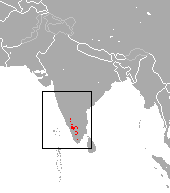Distribution and habitat
The Nilgiri tahr can be found only in India. It inhabits the open montane grassland habitat of the South Western Ghats montane rain forests ecoregion. At elevations from 1,200 to 2,600 m (3,900 to 8,500 ft), the forests open into large grasslands interspersed with pockets of stunted forests, locally known as sholas . These grassland habitats are surrounded by dense forests at the lower elevations. The Nilgiri tahrs formerly ranged over these grasslands in large herds, but hunting and poaching in the 19th century reduced their population. [1]
Conservation
As few as 100 Nilgiri tahrs were left in the wild by the end of 20th century. Since that time, their numbers have increased somewhat; in a comprehensive study of the Nilgiri tahr population in Western Ghats, the WWF-India has put the population at 3,122. [7] Their range extends over 400 km (250 mi) from north to south, and Eravikulam National Park is home to the largest population. [8]
In April 2025, the Second Synchronized Nilgiri Tahr Survey conducted jointly by the Tamil Nadu and Kerala Forest Departments under Project Nilgiri Tahr recorded a total of 2,655 individuals—1,303 in Tamil Nadu and 1,352 in Kerala. [9] [10] The survey was carried out across 14 forest divisions and 177 blocks, including 36 newly identified habitats. It involved 786 trained personnel and incorporated drone-based reconnaissance, GIS mapping, and standardized methods such as the double observer and bounded count techniques to ensure accuracy and consistency. [9]
Regional highlights
- Eravikulam National Park in Kerala continues to hold the largest single population. A wildlife census conducted in 2014 had counted 894 individuals, up from 640 during the first census in 1996. The 2025 synchronized survey reported 841 individuals in the park, accounting for the majority of Kerala's Nilgiri tahr population. [10]
- In Tamil Nadu, the main concentrations are in Mukurthi and Grass Hills National Parks, with additional sightings in Kodaikanal, Theni, Tirunelveli, and Kanyakumari districts. Some of these habitats have only recently been rediscovered and confirmed as viable tahr habitats through a combination of fieldwork and historical references, including ancient Tamil literature. [11]
- In a significant finding, low-elevation sightings were reported in Peyanar at 270 m above sea level, the lowest altitude recorded for the species. [9]
Population structure
The 2025 survey found a sex ratio of approximately 49 males per 100 females, and a young-to-female ratio of 50 to 100, both indicating a healthy reproductive population. [9]
Conservation initiatives
Project Nilgiri Tahr, launched by the Government of Tamil Nadu in October 2023, has emerged as one of India's most ambitious species-specific conservation programs. It includes shola grassland restoration, radio-collaring, health monitoring, and plans for captive breeding and reintroduction. [14] [9]
October 7 has been declared Nilgiri Tahr Day in Tamil Nadu, commemorating the legacy of conservationist E.R.C. Davidar and reinforcing the cultural significance of the species. [15] [14]
Historical and current estimates
| Period / Event | Estimated Population |
|---|
| Late 20th century low | Fewer than 100 |
| WWF‑India estimate (early 2000s) | ~3,122 |
| April 2025 synchronized survey | 2,655 (Tamil Nadu + Kerala) |
This page is based on this
Wikipedia article Text is available under the
CC BY-SA 4.0 license; additional terms may apply.
Images, videos and audio are available under their respective licenses.






